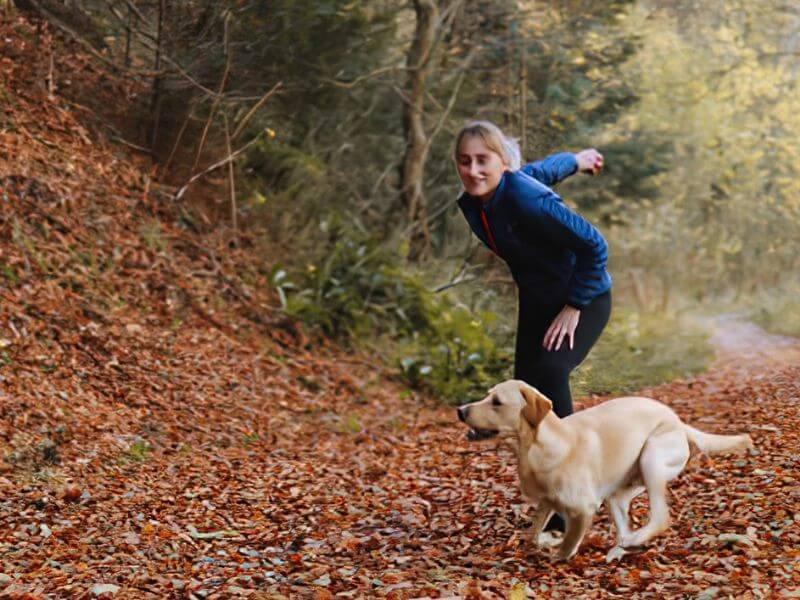
Home » Play Ball… Safely

Cody strained at his leash as he entered my examination room. A brown and white pitbull mix with soft eyes, large neck and shoulder muscles, and a beautiful sheen to his coat, he rubbed the side of his big body against my legs then flipped over onto his back, begging for a belly rub. His tongue lolled to one side and he sported a silly grin. On the inside of his left knee, I could see a prominent scar from recent surgery.
Cody had ruptured his cranial cruciate ligament (CCL), a structure that supports the knee joint, about four months previously. He had endured a lengthy and expensive surgery to stabilize his knee in the hopes of reducing the chance that he would develop severe arthritis, and to help him have a pain-free life. Cody and his person were consulting with me to arrange a conditioning and retraining program to enable him to safely return to all the activities he loved.
After examining Cody and prescribing some exercises to rebuild his core and hind limb musculature, Cody’s person asked, “When can he play ball again? That’s his favorite thing to do!”
As I considered my answer, I thought about Harper, who came in last week with lumbosacral disease that had caused months of weakness and back pain. Her person brought me a video showing Harper leaping for a frisbee and landing on the rear legs, back hyperextended as she tried to capture that hovering object. I recalled the many other dogs who come to me with CCL ruptures, iliopsoas strains, and bulging lumbosacral disks and how often their people tell me that their dogs love to retrieve.
At home that evening, I watched my crazy Golden Retriever slide on the grass and then do a 360-degree spin as he tried to grab his ball, despite the fact that I had thrown it far enough that it was stationary when he reached it.
What is it about retrieving that makes many dogs (and their people) lose their minds, completely forgetting self-preservation and control? After delving a bit deeper into canine behavior and neurology, here’s what I learned.
When we throw a ball, we are stimulating our dog’s prey drive and innate instinct to chase. Your dog cannot help it—they HAVE to overtake that moving object! Why? Well, Ray and Lorna Coppinger, biologists, breeders, trainers, and champion sled dog racers with decades of experience with thousands of dogs, consider retrieving to be an instinctual behavior. Like other instinctual behaviors (sex, eating, and scenting), chase and catch are internally rewarding and provide deep joy, contentment, and optimism to many dogs.
Coppinger says, “If a dog gets pleasure out of performing (a behavior), it keeps looking for places to display it. The animal will search for the releaser of (the behavior) because it gets rewarded so luxuriously for performing.” In this case, you are the releaser, the giver of this luxurious reward, so “a good retriever sits there and begs you to throw the ball again.”
In addition, we also are rewarded, because the game of retrieving is relational. You are the person who gives this gift to your dog and your dog seeks to experience this joy through you. When our dogs are so happy, we are happy. This must be a good thing, right? How wonderful to be able to give our dogs the gift of joy!
From a neurological point of view, the chemical messenger responsible for that feeling of bliss is dopamine. It’s the same neurotransmitter that gives you that ever-so-brief but wonderful feeling at your first taste of a delicious food and during sex. Recent studies suggest, however, that not only does dopamine provide that blissful feeling, it also drives the individual to seek that feeling over and over. This is why drugs like cocaine that cause the release of dopamine are so addictive.
Likewise, when your dog experiences that dopamine release during the chase and catch, he wants more, and more, and more. And when your dog brings the ball back to you, you see those bright eyes and that body leaping and begging for you to throw the object again, and it is clear that they love this game! And so, you throw again, and again, and again.
However, more is happening to your dog’s body while retrieving than just a flood of dopamine. During the chase, your dog is highly aroused. His eyelids are wide open, his pupils are dilated, and his muscles are tensed for action. Adrenaline is coursing through his veins and the entire sympathetic nervous system is on high alert. When the ball moves, he HAS to chase! He is not thinking about the tree, or the ditch, or the suddenly approaching car that might be in the way. He doesn’t care whether he has to leap off a wall, slide on some gravel, or spread-eagle to snag the ball. And if he does get injured, he won’t feel any pain. At least not until much later. That’s adrenaline for you!

As your dog retrieves the first… second… third… maybe fifth or sixth ball, their muscles start to tire and soon they reach overload so that they no longer can fully control and support their movements. Now, when your dog does those amazing athletic maneuvers to snag the ball, soft tissues like the cranial cruciate ligament, iliopsoas muscle and tendon, and the muscles and ligaments that support the vertebrae are overstretching. Minor tears are occurring. Then the ball is thrown seven, 10, 12 times or more, and ultimately, your dog lies down, exhausted.
Don’t use the retrieve to tire your dog out. Use it to give your dog joy.
That period between when your dog’s muscles are in overload and when your dog lies down exhausted is the injury zone. (See Figure—The Bliss – Injury Continuum.) But remember, with all that adrenaline, your dog doesn’t feel the injuries happening, so you have no idea that the tissues are being used beyond their capacity.
When this game is repeated day after day, month after month, those small tears become large ones, and suddenly it is evident that your dog is in pain and has an injury. Of course, it hasn’t been sudden at all—what seemed sudden is just the final result of repeated stress and strain until the tissues give way.
The key to safe retrieving is to stop your dog when it arrives at the point of muscle overload, just like you should stop yourself from reaching for a second bag of chips, no matter how good the first bag tasted.
How do you recognize overload? Watch your dog’s tongue. When the tip of the tongue becomes wider and/or curls up, that is your signal that your dog has just used its final mechanism to dissipate body heat. And that’s a pretty good indicator that your dog has reached muscle overload. So, even if that happens on the second retrieve, be the grown-up; stop the game and make sure your dog is in a cool place to rest and recover. In essence, don’t use the retrieve to tire your dog out. Use it to give your dog joy.
Here are some guidelines to make the retrieving game safer for your dog. Teach other family members these guidelines and enforce them. In the long term, they will protect your dog’s health and your finances.
